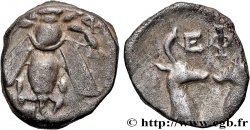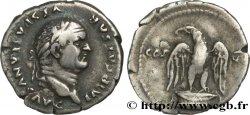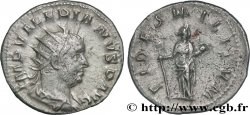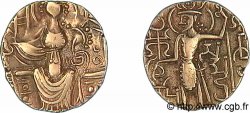v34_0197 - IONIA - EPHESUS Tétradrachme
MONNAIES 34 (2008)
Starting price : 650.00 €
Estimate : 950.00 €
Realised price : 837.00 €
Number of bids : 3
Maximum bid : 1 308.00 €
Starting price : 650.00 €
Estimate : 950.00 €
Realised price : 837.00 €
Number of bids : 3
Maximum bid : 1 308.00 €
Type : Tétradrachme
Date: c. 390-380 AC.
Mint name / Town : Éphèse
Metal : silver
Diameter : 25 mm
Orientation dies : 11 h.
Weight : 14,85 g.
Rarity : R2
Emission: classe A
Coments on the condition:
Exemplaire frappé sur un flan large et ovale, parfaitement centré avec le grènetis complet au droit. Usure superficielle. Beau droit. Revers bien venu à la frappe. Patine grise avec des reflets métalliques dorés
Predigree :
Cet exemplaire provient de la vente Hirsch 160, 23-25 novembre 1988, n° 200
Obverse
Obverse description : Abeille vue de dessus.
Obverse legend : E-F
Reverse
Reverse description : Protomé de cerf à droite, agenouillé, tournant la tête à gauche ; dans le champ à gauche, un palmier.
Reverse legend : SANNIWN
Reverse translation : (Sannion).
Commentary
C’est le seul exemplaire signalé avec ce nom de magistrat monétaire. Notre tétradrachme appartient à la classe la plus ancienne de ce type lié au coin de droit n° 2, associé à quinze noms de magistrats monétaires. Au droit, le coin commence à se boucher sur le phi d’Éphèse. Au revers, petit défaut de métal devant le cou du cerf.
This is the only example reported with this name of a monetary magistrate. Our tetradrachm belongs to the oldest class of this type linked to the obverse die no. 2, associated with fifteen names of monetary magistrates. On the obverse, the die is beginning to fill up on the phi of Ephesus. On the reverse, there is a small metal defect in front of the stag's neck.
This is the only example reported with this name of a monetary magistrate. Our tetradrachm belongs to the oldest class of this type linked to the obverse die no. 2, associated with fifteen names of monetary magistrates. On the obverse, the die is beginning to fill up on the phi of Ephesus. On the reverse, there is a small metal defect in front of the stag's neck.








 Report a mistake
Report a mistake Print the page
Print the page Share my selection
Share my selection Ask a question
Ask a question Consign / sell
Consign / sell
 Full data
Full data












